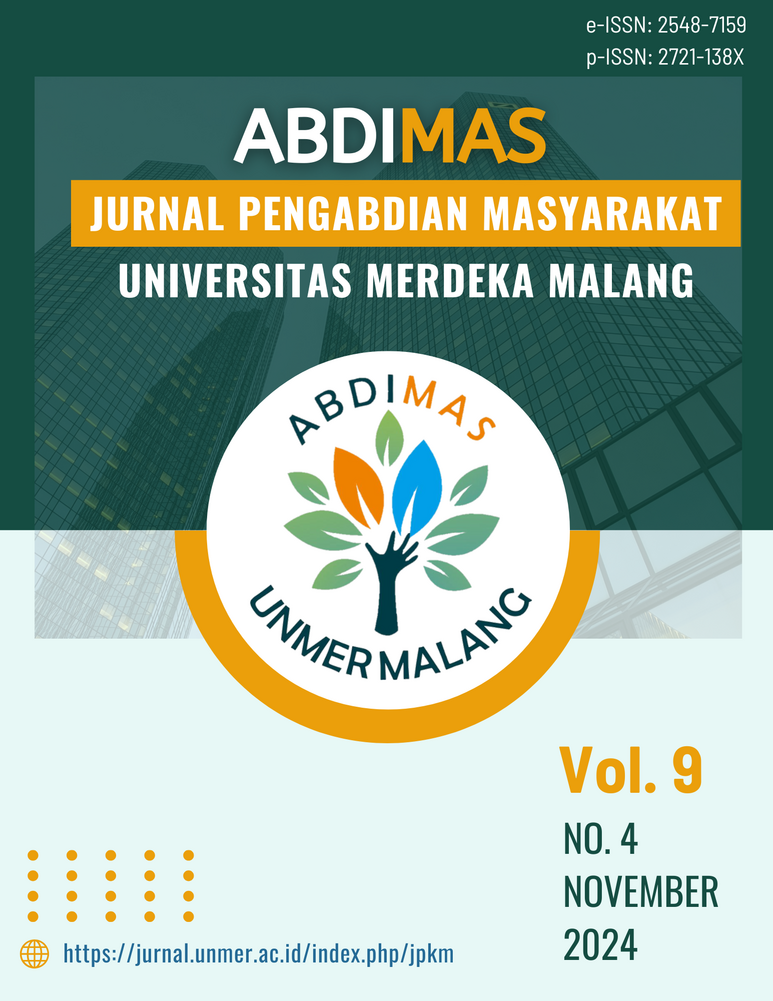Renewable energy transformation using solar panels in the Red Tilapia Intensive System community
DOI:
https://doi.org/10.26905/abdimas.v9i4.14355Keywords:
Asset-Based Community Development (ABCD), Energy efficiency, Redtis communities, Solar panelsAbstract
The transition to renewable energy is a strategic response to the global energy crisis and climate change. A community service project was conducted to promote energy independence for the Red Tilapia Intensive System (REDTIS) community by installing solar panels. Utilizing the Asset-Based Community Development (ABCD) method, the initiative involved installing two solar panels with a total capacity of 200 WP, a 100 AH battery, a 30 A solar charge controller, and a 500 Watt inverter to power a 100-Watt aerator. The project began with community asset identification, renewable energy analysis, system design, installation, and performance monitoring. The solar panel system generated an average of 1 kWh daily, covering approximately 41.3 percent of the aerator's 2.4 kWh daily energy requirement. This reduced reliance on conventional energy, lowering electricity costs and carbon emissions. While the solar panels did not fully meet the aerator's energy needs, the initiative demonstrated significant potential for scalability. Enhancing energy production, storage, and management is expected to achieve complete energy independence. This project serves as a replicable model for other communities seeking sustainable energy solutions.
Downloads
References
Arifin, Z., Saroso, B. A., Kurniawan, A., & Ageftry, F. D. (2022). Pemanfaatan energi surya sebagai energi alternatif aerator untuk meningkatkan kualitas air kolam ikan hias berukuran kecil. Elektrika, 14(2), 66-75. http://dx.doi.org/10.26623/elektrika.v14i2.5752
Bagas, M. C., Sholikhah, R. A., Faroha, S., & Rahmawati, V. (2024). Implementasi asset based community development dalam menumbuhkan modal sosial, ekonomi dan budaya pada masyarakat pesisir Desa Branta. Community Development: Jurnal Pengembangan Masyarakat Islam, 7(2), 168-188. https://doi.org/10.21043/cdjpmi.v7i2.22509
Cholily, Y. M., Effendy, M., Indrawan, R. F., Subairi, S., Hakim, R. R., & Suwandayani, B. I. (2024). Diseminasi pakan mandiri pada budidaya ikan berbasis teknologi Resirculating Aquaculture System (RAS) berbantuan solar cell di Desa Parangargo. Community Development Journal: Jurnal Pengabdian Masyarakat, 5(5), 10252-10260. https://doi.org/10.31004/cdj.v5i5.36270
Corkish, R. (2004). Solar cells. In C. J. Cleveland (Ed.), Encyclopedia of energy (pp. 545-557). Elsevier. https://doi.org/10.1016/B0-12-176480-X/00328-4
da Costa, T. P., da Costa, D. M. B., & Murphy, F. (2024). A systematic review of real-time data monitoring and its potential application to support dynamic life cycle inventories. Environmental Impact Assessment Review, 105, 107416. https://doi.org/10.1016/j.eiar.2024.107416
Dwisari, V., Sudarti, S., & Yushardi, Y. (2023). Pemanfaatan energi matahari: Masa depan energi terbarukan. OPTIKA: Jurnal Pendidikan Fisika, 7(2), 376-384. https://doi.org/10.37478/optika.v7i2.3322
Harahap, P., Adam, M., & Oktrialdi, B. (2022). Optimasi kapasitas rooftop Pv off grid energi surya berakselerasi di tengah pandemi covid-19 untuk diimplemtasikan pada rumah tinggal. RESISTOR (Elektronika Kendali Telekomunikasi Tenaga Listrik Komputer), 5(1), 31-38. https://doi.org/10.24853/resistor.5.1.31-38
Hariyanto, W., Utama, S. N., & Fatchurrohman, F. (2023). Implementation of renewable energy using smart light solar cell system for mosque energy efficiency. Abdimas: Jurnal Pengabdian Masyarakat Universitas Merdeka Malang, 8(4), 538–548. https://doi.org/10.26905/abdimas.v8i4.11173
Muntini, M. S., Rahayu, L. P. P., Fatimah, I., Faridawati, F., Suyatno, S., Yuwana, L., & Indrawati, S. (2024). Implementasi pemanfaatan Pembangkit Listrik Tenaga Surya (PLTS) untuk peningkatan produktivitas budidaya ikan dan pertanian di Kalurahan Sumbersari. PESARE: Jurnal Pengabdian Sains dan Rekayasa, 2(2), 188-199. https://doi.org/10.24815/pesare.v2i2.38943
Nova, N., Parwati, N. M. S., & Fera, F. (2023). Analisis kendala budidaya ikan nila dengan metode bioflok di Desa Karawana Kec. Dolo Kab. Sigi. Transformasi: Journal of Economics and Business Management, 2(1), 257-263. https://doi.org/10.56444/transformasi.v2i1.525
Panagoda, L. P. S. S., Sandeepa, R. A. H. T., Perera, W. A. V. T., Sandunika, D. M. I., Siriwardhana, S. M. G. T., Alwis, M. K. S. D., & Dilka, S. H. S. (2023). Advancements in Photovoltaic (Pv) technology for solar energy generation. Journal of Research Technology & Engineering, 4(3), 30-72.
Rinawati, A., Arifah, U., & Faizul, A. H. (2022). Implementasi model Asset Based Community Development (ABCD) dalam pendampingan pemenuhan kompetensi leadership pengurus MWC NU Adimulyo. Ar-Rihlah: Jurnal Inovasi Pengembangan Pendidikan Islam, 7(1), 1-11. https://doi.org/10.33507/ar-rihlah.v7i1.376
Saleh, J., Budi, S., & Salam, S. (2021). Pengembangan budidaya ikan nila. Pusaka Almaida.
Sunaryono, S., Diantoro, M., Taufiq, A., Susanto, H., Najmi, M. I., & Yuliana, F. (2023). Pemanfaatan teknologi sel surya untuk optimalisasi budidaya ikan lele berbasis sistem biofloc-aquaponic. DEDIKASI: Jurnal Pengabdian Masyarakat, 5(1), 51-57. https://doi.org/10.32332/d.v5i1.5684
Supari, S., Pinandita, S., Pratama, S. Y., & Abimanyu, L. B. (2022). Optimalisasi listrik tenaga surya dalam mobilitas perahu: Metode dan analisanya. PT. Literasi Nusantara Abadi Grup.
Wati, E. K. (2020). Aplikasi manajemen & efisiensi energi. LP_UNAS.
Downloads
Published
How to Cite
Issue
Section
License
Copyright (c) 2024 Abdimas: Jurnal Pengabdian Masyarakat Universitas Merdeka Malang

This work is licensed under a Creative Commons Attribution-ShareAlike 4.0 International License.
Authors who publish with this journal agree to the following terms:
- Copyright of the published articles will be transferred to the journal as the publisher of the manuscripts. Therefore, the author confirms that the copyright has been managed by the journal.
- Publisher of Abdimas: Jurnal Pengabdian Masyarakat Universitas Merdeka Malang is University of Merdeka Malang.
- The copyright follows Creative Commons Attribution-ShareAlike License (CC BY SA): This license allows to share, copy, and redistribute the material in any medium or format, adapt, remix, transform, and build upon the material, for any purpose, even commercially.





